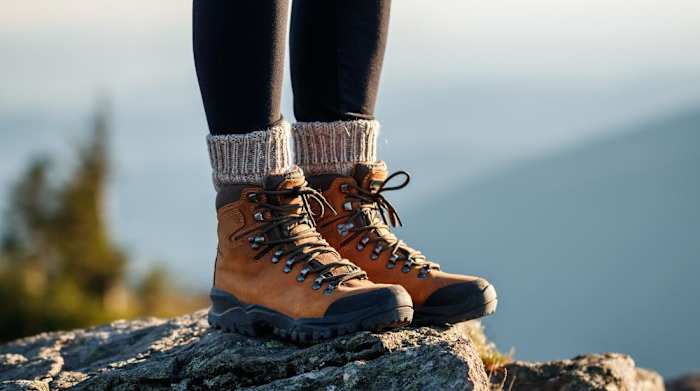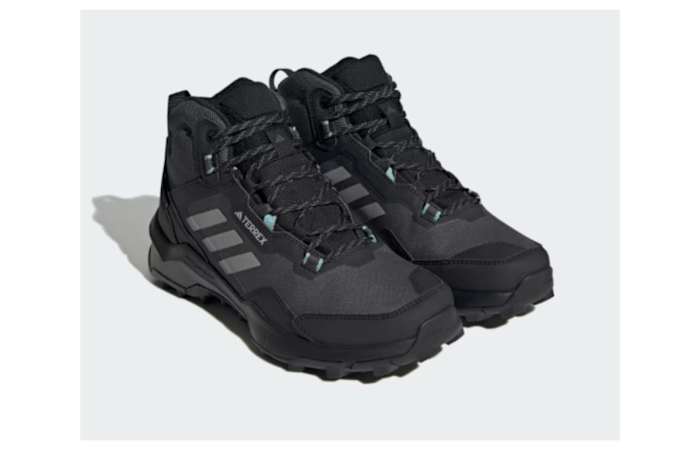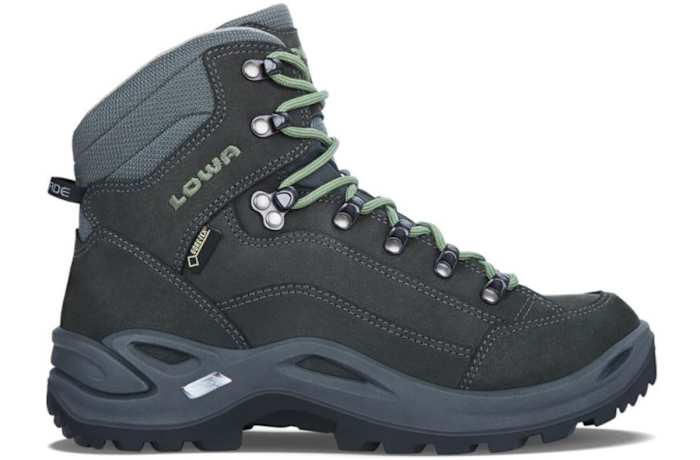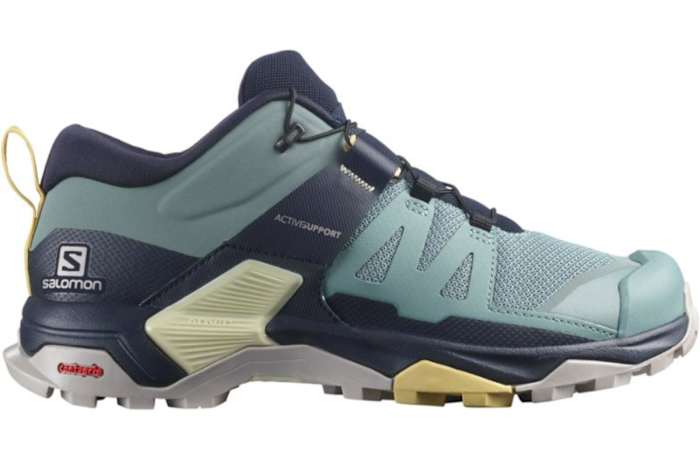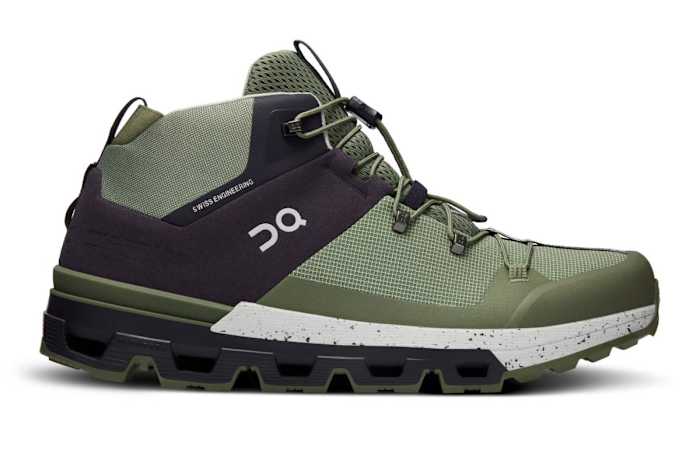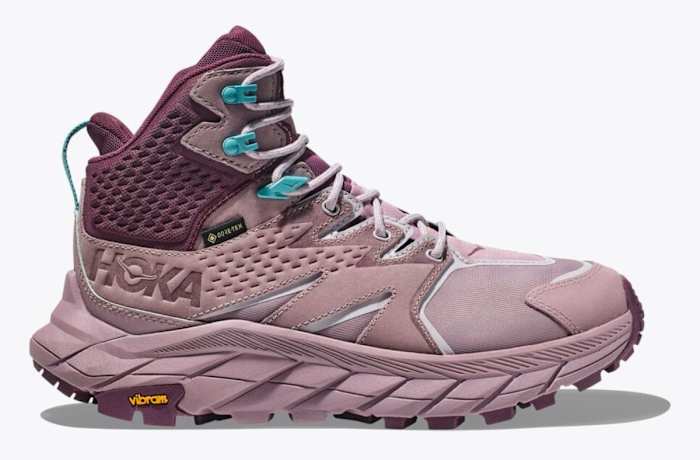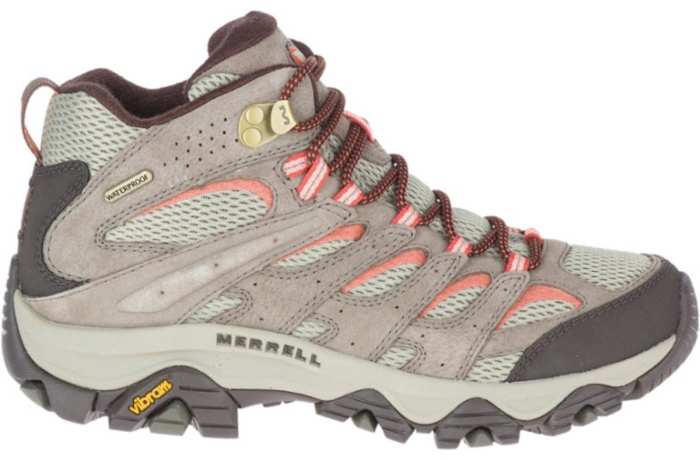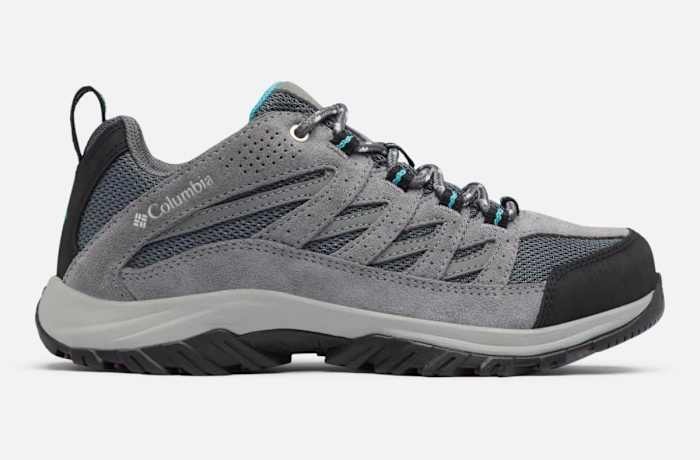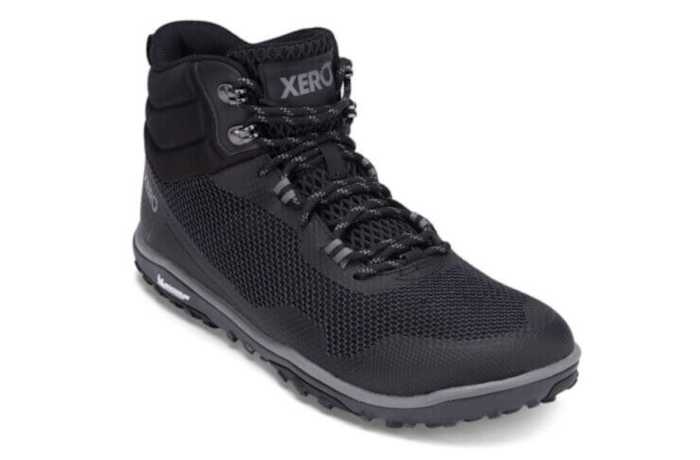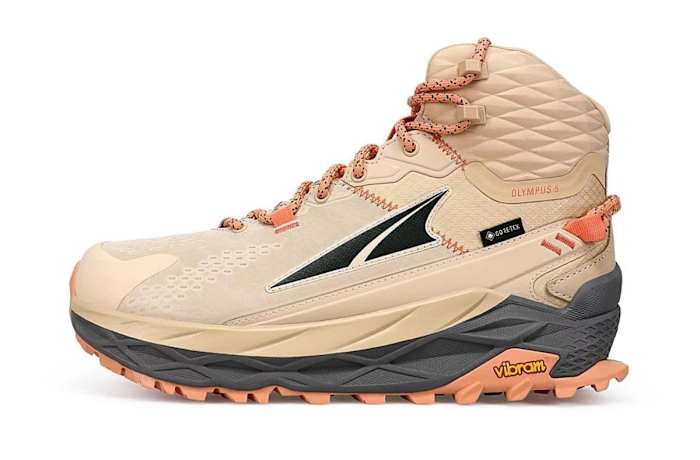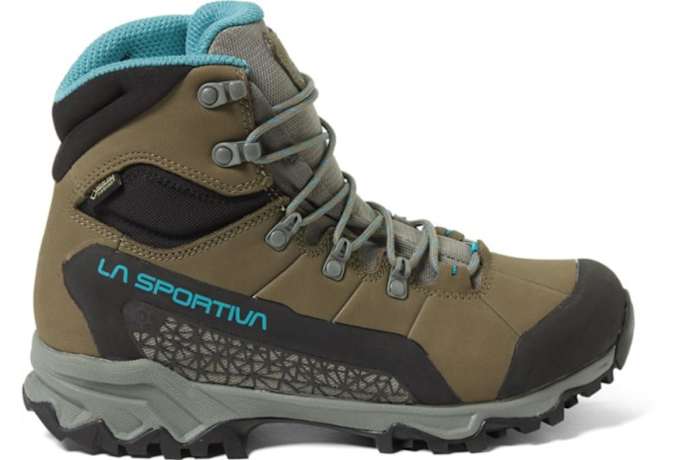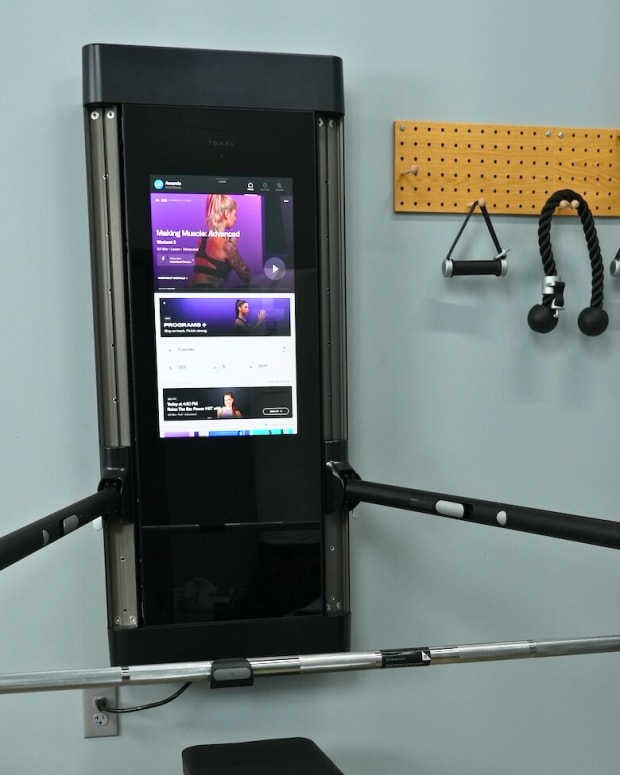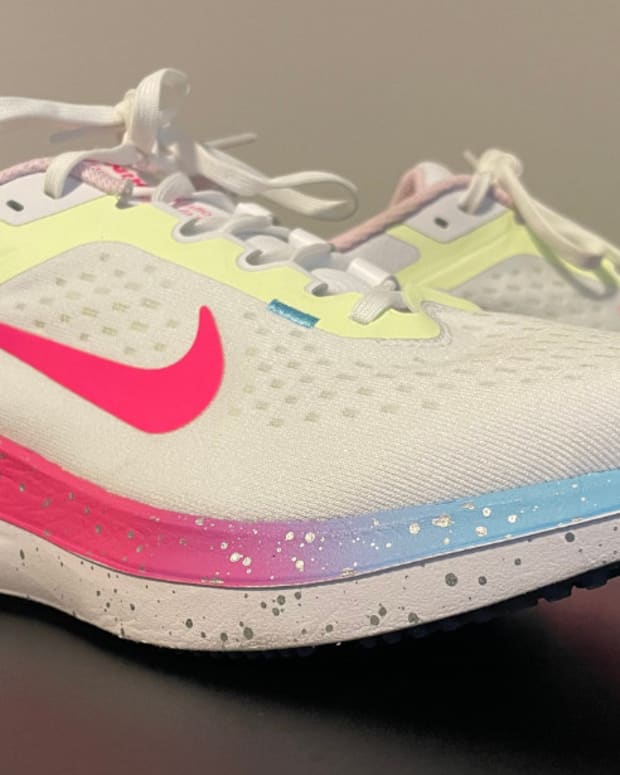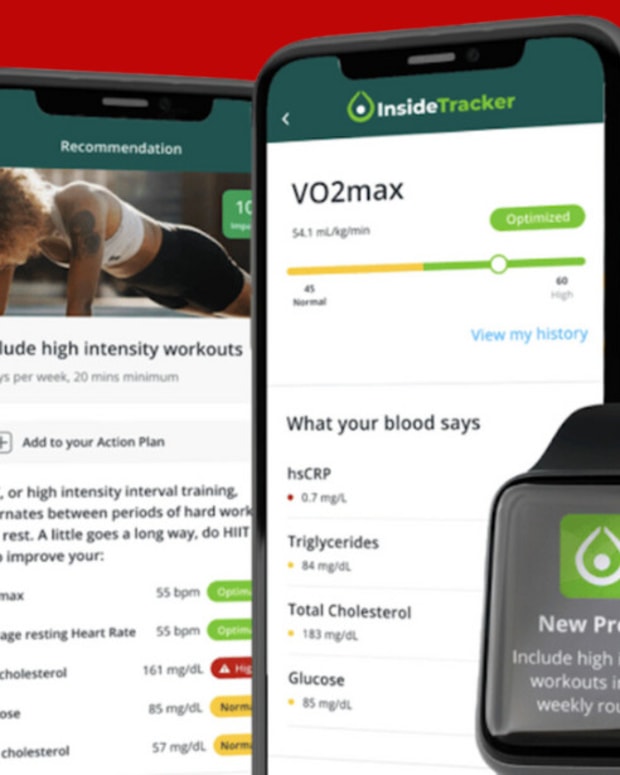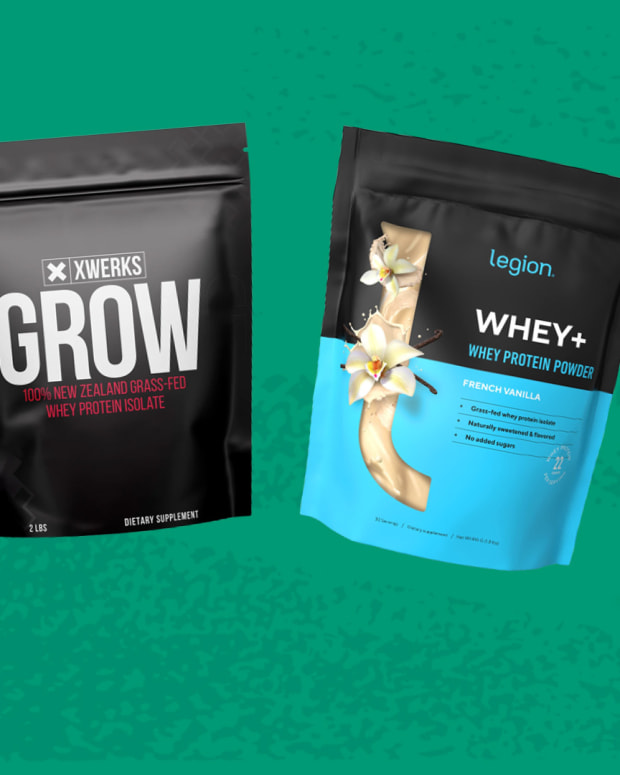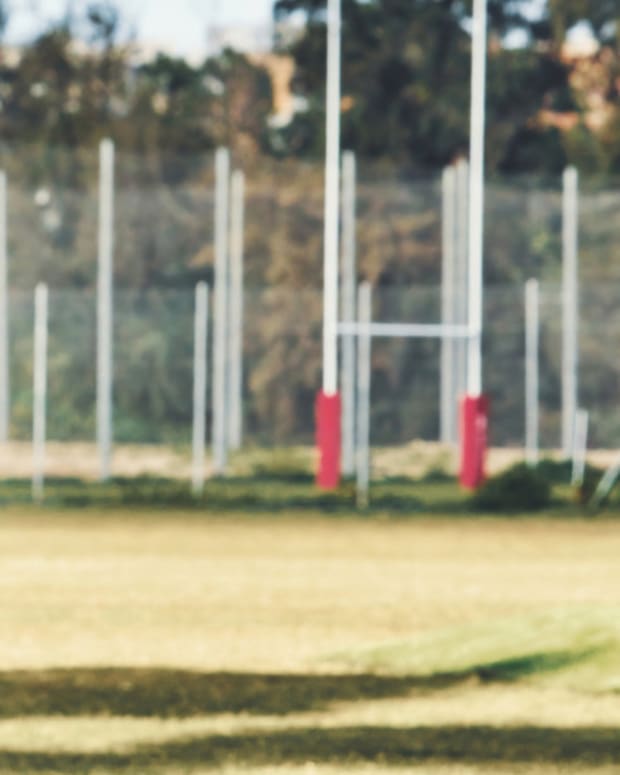The products featured in this article have been independently reviewed. When you buy something through the retail links on this page, we may earn commission at no cost to you, the reader. Sports Illustrated editorial staff are not involved in the creation of this content. Learn more here.
If you’re heading to the trails, you need a solid pair of hiking boots to keep you upright and moving at a comfortable pace. Women’s hiking boots are no longer smaller versions of men’s boots. They’re tailored to the wider forefoot and narrower heel of the average woman. The hard part is finding a model that fits your feet and has features that complement your hiking style and goals.
Women’s hiking boots come in different types and styles, from mountaineering boots for more technical adventures to trail runners that can double as women’s running shoes. Not everyone needs a waterproof boot or one with deep lugs if wet rocks and roots aren’t underfoot. Others may need extra ankle support and traction that grip versatile surfaces. Shoe weight is another factor that can play into your final decision, especially if you’re going on long, multi-day hikes or heading into the backcountry.
We’ve picked the best hiking books for women in a variety of categories. When choosing, we considered the boots’ design, waterproofing, fit and materials. If you need help deciding what you need, we’ve also included a comprehensive guide to help you make your final pick in 2024.
Our Picks for the Best Hiking Boots for Women in 2024:
- Best Overall Hiking Boots for Women: adidas Terrex AX4 Mid Gore-Tex Hiking Shoes
- Best Waterproof Hiking Boots for Women: Lowa Renegade GTX Mid Hiking Boots
- Best Hiking Shoes for Women: Salomon X Ultra 4 GORE-TEX Hiking Shoes
- Best Hiking and Trail Running Shoes for Women: ON Running Cloudtrax
- Most Comfortable Hiking Boots for Women: Hoka Anacapa 2 Mid GTX Hiking Boots
- Best Budget Hiking Boots for Women: Merrell Moab 3 Mid Waterproof Hiking Boots
- Best Budget Hiking Shoes for Women: Columbia Women’s Crestwood Hiking Shoes
- Best Lightweight Hiking Boots for Women: Xero Scrambler Mid-Ultra-Light Hiking Boot
- Best Hiking Boot for Cold Elements: Keen Revel IV Polar Boot
- Best Hiking Boot for Wide Feet: Altra Women’s Olympus 5 Hike Mid GTX
- Best Backpacking Boots for Women: La Sportiva Nucleo High II GTX Hiking Boots
- Best Leather Hiking Boots for Women: Lowa Renegade GTX Mid Hiking Boots
Best Overall Hiking Boots for Women: adidas Terrex AX4 Mid Gore-Tex Hiking Shoes
Key features and specs:
- Weight per pair: One pound, 9.75 ounces
- Materials: Synthetic/textile (upper), GORE-TEX/breathable membrane (lining), EVA (midsole), continental rubber (outsole)
- Waterproof?: Yes
- Width options: One
- Price: $140
The adidas Terrex AX4 Mid Gore-Tex Hiking Shoes are one of our top picks for the protection and stability they combine with the weight of a lighter trail runner. The design cuts weight by using a synthetic upper with a waterproof Gore-Tex membrane. The combination is light, but waterproof. Users from REI.com report their feet stayed dry during hikes in Hawaii and other wet locations, highlighting the success of the waterproof design. Those same reviewers noted that the AX4s remained breathable despite their ability to keep water out.
An EVA midsole also cuts down on weight. This light plastic is soft, flexible and durable. On the outside, rubber outsoles create a “grippy” feel, according to Amazon reviewers. Both the rubber and the lug design and layout provide a balanced grip and water shedding that keeps wearers stable in wet conditions. However, watch out on sizing, as there are a handful of reviewers on REI.com who mention that the AX4s run about a half size too big.
Pros:
- Synthetic upper and GORE-TEX liner keep water out
- Good combination of breathability and waterproofing
- Lightweight materials
- Grippy outsoles that shed water
Cons:
- Run a little big
Best Waterproof Hiking Boots for Women: Lowa Renegade GTX Mid Hiking Boots
Key features and specs:
- Weight per pair: Two pounds, two ounces
- Materials: Nubuck leather (upper), GORE-TEX/polyester (lining), polyurethane (mid-sole), Vibram (outsole)
- Waterproof?: Yes
- Width options: Two
- Price: $245
The Lowa Renegade GTX Mid tops more than one list of the best hiking boots for women. The materials tick all the boxes for durability, waterproofing and comfort. A durable Nubuck leather upper has natural water resistance, and it breaks in faster than more expensive full-grain leather. Keep in mind that leather boots require regular care and conditioning, and Nubuck will show wear and tear easier than full-grain leather. However, it balances durability, water resistance and price to create a tough boot for difficult terrain.
The Nubuck is backed by a GORE-TEX and polyester lining that further prevents water from touching the feet. The Renegades also contain materials and design features that increase stability, such as polyurethane frames, Vibram outsoles and full-length nylon shanks. Nylon shanks give the shoe a stiffer feel that prevents fatigue when you’re on steep, rocky trails or carrying a heavy pack. The mid-height offers ankle stability. Plus, you can lock in the laces to get the right tension on different areas of the feet without disrupting circulation. Last are the lugs, which have a strong grip and do a good job of shedding mud and water on wet trails.
The Renegade comes in regular and wide widths. Reviewers on REI.com report that the Renegades run a bit small and narrow (even the wide width), so you might need to order a half size up.
Pros:
- High-quality materials with Nubuck leather and GORE-TEX lining for waterproofing
- Added stability of the nylon shanks
- Comfortable lace locking system
- Strong lug grips and water shedding
Cons:
- Runs small and narrow
Best Hiking Shoes for Women: Salomon X Ultra 4 GORE-TEX Hiking Shoes
Key features and specs:
- Weight per pair: One pound, six ounces
- Materials: Synthetic textile (upper), textile (lining), rubber (outsole)
- Waterproof?: No
- Width options: One
- Price: $120
The Salomon X Ultra 4 GORE-TEX Hiking Shoes are super lightweight hiking shoes, weighing in at only one pound, six ounces per pair. That light weight, coupled with a grippy outsole and solid chevron lug design, makes them a capable shoe for wet, muddy and rough terrain, according to reviews on Amazon.com. They also have a molded insert—which Salomon calls an Advance Chassis—embedded in the outsole to give the shoe better lateral support, yet it remains flexible enough to give the shoe a sturdy feel.
The mesh, synthetic upper keeps the weight low and offers some water protection, though they’re not waterproof. Salomon’s Quicklace system gives users quick entry and exit, and includes a one tug tightening design. A fit issue to note is that the Ultra 4s have a larger toe box than the previous model and run a bit long. Additionally, while the tongue is well-padded and comfortable, reviewers from Amazon.com noted that it tends to shift during use. However, those small issues outweigh the comfort, lightweight design and stable traction of these hiking shoes.
Pros:
- Grippy chevron lug design
- Lightweight
- Easily adjust laces
Cons:
- Tongue easily shifts
- Runs long
Best Hiking and Trail Running Shoes for Women: On Running Cloudtrax
Key features and specs:
- Weight per pair: 12.9 ounces
- Materials: 85% recycled polyester
- Waterproof?: Yes, waterproof option
- Width options: One
- Price: $189.99
The On Cloudtrax hiking boot will give you a high-performance hiking experience. The Cloudtec cushioning system and dual-layer midsole provide unbeatable comfort, allowing you to hike for miles with ease. ON Speedboard tailoring technology in the midsole will spring you forward in any terrain. The Missiongrip outsole allows you to hit any terrain with confidence. Whether you are in the streets or on a mountain, you can be sure that these boots provide the grip you need.
The upper is constructed with 85 percent polyester, giving you a well-ventilated experience in any climate. Plus, the toe-cap mudguard adds extra protection for a variety of terrains. A convenient speed lacing system allows you to effortlessly ease into the shoe. The On Cloudtrax hiking boot will provide you with an elevated, comfortable hiking experience.
Pros:
- Well-cushioned and supportive
- True to size
- Lightweight
Cons:
- Not the best traction compared to other shoes on the market
Most Comfortable Hiking Boots for Women: Hoka Anacapa 2 Mid GTX Hiking Boots
Key features and specs:
- Weight per pair: One pound, 12 ounces
- Materials: GORE-TEX and Nubuck leather (upper), EVA (midsole), Vibram rubber (outsole)
- Waterproof?: Yes
- Width options: One
- Price: $185
Hoka makes some of the most well-cushioned running shoes on the market, and their hiking boots aren’t far behind. The Anacapa Mid GTX Hiking Boots have a compression molded EVA midsole that provides plenty of cushioning for long day hikes. It also cuts down on any break-in time, as noted by reviewers on REI.com: “No breaking in needed, and it felt like I was walking on a pillow of clouds.”
Beyond cushioning, these boots also feature a quick-lace system, extended heel geometry to help through transitions and Vibram Megagrip rubber outsoles. The grippy outsoles make these appropriate for rough terrain. The Nubuck and GORE-TEX upper keeps water out, but remains relatively breathable. Hoka also uses recycled and ethically sourced materials in the GTX to form a more eco-friendly, sustainable shoe. A note on sizing—several reviewers on REI.com point out that the GTXs are narrower than Hoka running shoes, and the GTXs don’t come in wide widths. Some reviewers on REI.com also had issues with rubbing on the ankle bone.
Pros:
- Excellent padding and cushioning
- Comfortable with little break-in time needed
- Grippy outsole
- Eco-friendly materials
Cons:
- Can rub on the ankles
- Run narrow with no wide widths available
Best Budget Hiking Boots for Women: Merrell Moab 3 Mid Waterproof Hiking Boots
Key features and specs:
- Weight per pair: One pound, 13 ounces
- Materials: Pigskin leather and mesh (uppers), recycled mesh (lining), Super Rebound compound (midsole), Vibram TC5+ (outsoles)
- Waterproof?: Yes
- Width options: Two
- Price: $145
The Merrell Moab 3 Mid Waterproof Hiking Boots may be slightly more affordable than other boots on our list, but hikers aren’t giving up quality or technology when they buy them. The Moab 3s are an update of the popular Merrell Moab 2. Improvements include partially recycled materials, improved support in the insoles, better cushioning in the midsole and improved (grippier) Vibram outsoles. They also contain reinforced heel cushioning for improved shock absorption.
The Moab 3’s mesh and leather upper protects the feet while remaining breathable, and a waterproof membrane keeps water out. Merrell adds a nylon arch shank to give the boot some rigidity for rocky, steep terrain. That shank both protects and supports the foot for longer trekking when carrying a heavy pack.
These boots are available in regular or wide width, and reviewers on REI.com report that they’re “truly wide width.” Some reviewers, however, find that the Moab 3s run a bit small, so you might need to order a half size up.
Pros:
- Partially recycled materials
- Comfortable arch protection and support with nylon shank
- Wide-width sizes truly accommodate wider feet
Cons:
- May need to order half size up
Best Budget Hiking Shoes for Women: Columbia Women’s Crestwood Hiking Shoes
Key features and specs:
- Weight per pair: One pound, 4.2 ounces
- Materials: Leather and mesh (upper), Techlite EVA (midsole), Omni-Grip rubber (outsole)
- Height: Low
- Waterproof?: No
- Width options: Two
- Price: $80
Women looking for the best hiking shoes on a budget should look no further to Columbia’s Crestwood Hiking Shoes. These shoes skip more advanced technology for solid basics that perform well. They feature a Techlite midsole, which is a flexible, durable foam. It offers good support, but keeps the shoe weight low.
A durable leather and mesh upper can handle heavy use without fraying or splitting. They have an Omni-Grip rubber outsole with traction that grips well over dirt and rocks in dry conditions. A reviewer on Columbia.com puts it like this: “Just what I was looking for. Very comfortable yet supportive. Great alternative to my taller hiking boots for just walking or more mild terrain.” That sums up the pros of the Crestwood, though many hikers find them comfortable on rougher terrain. Keep in mind that these shoes aren’t waterproof, but there is a waterproof version available.
Pros:
- Lightweight and supportive
- Affordable price
- Durable for a budget-friendly shoe
Cons:
- Not meant for wet conditions
Best Lightweight Hiking Boots for Women: Xero Scrambler Mid-Ultra-Light Hiking Boot
Key features and specs:
- Weight per pair: 9.4 ounces
- Materials: Michelin Fiber Lite sole, TrailFoam
- Waterproof?: No
- Width options: One
- Price: $169.99
The Scrambler Mid-Ultra-Light hiking Boot delivers exceptional performance and comfort for your hiking expeditions.
The Michelin Fiber Lite sole is engineered with an embedded textile layer for durability, and flexibility. Mud-shedding lugs that mimic bike tires make these shoes ideal for any terrains you may encounter.
The dynamic combination of Trailfoam and Fiber Lite technology provides ideal comfort on rugged trails. These shoes have optimal cushioning while still remaining lightweight, making every step a breeze. A wider toe box gives you optimal comfort and toe spreadability, allowing your feet to move naturally. These boots are made with a low-ground design for a steady and swift experience on even the most challenging paths.
The mid wraps both of the boot’s layers in the upper, creating a thick outer appearance that delivers stability without sacrificing breathability. “Another thing I fairly quickly noticed was how breathable the uppers were. Even nearing triple digit temperature, my feet remained cool and dry from sweat” says wear tester Levi Bettweiser. These boots will keep your feet well-ventilated and protected on your hiking ventures.
Pros:
- Lightweight and breathable
- Comfortable for long hikes
Cons:
- Reviewers complain about sand easily getting in boot
- Not the best for wet terrains
Best Hiking Shoe for Cold Elements: Keen Revel IV Polar Boot
Key features and specs:
- Weight per pair: None listed
- Materials: Nylon, Keen Warm insulation, Keen Dry waterproof membrane, EVA foam midsole
- Waterproof?: Yes
- Width options: One
- Price: $180
The Keen Revel IV Polar Boot has the responsiveness of a light hiker with added warmth and comfort.
The outsole is constructed with Keen Polar Traction rubber to keep you grounded in snowy and icy conditions. Five millimeter multi-directional lugs and a midfoot shank provide unmatched traction and lightweight support. To top it off, these shoes have a rubber tip for long-lasting wearability.
Rest assured your feet will be warm, since these boots are thoughtfully designed with Keen Warm Recycled PET insulation. These shoes are made with three layers of heat-trapping materials under your foot for prime insulation. Even with all of this insulation, these shoes are made with eco anti-odor fto keep your feet feeling and smelling fresh. Keen Dry technology gives these shoes a waterproof yet well-ventilated membrane.
Pros:
- Well insulated
- Great traction for icy terrains
Cons:
- Some reviewers complain that they run narrow
- Can be stiff
Best Hiking Shoe for Wide Feet: Altra Women’s Olympus 5 Hike Mid GTX
Key features and specs:
- Weight per pair: 15 ounces
- Materials: Leather upper
- Waterproof?: Yes
- Width options: One
- Price: $220
Maneuver through the trails with ease in Altra Women’s Olympus 5 Hike Mid GTX. These shoes will deliver performance and comfort in any weather conditions.
Made with GORE-TEX technology, these shoes are equipped to keep your feet dry in any element. The Vibram Megagrip outsole provides an adaptable grip on any surface–wet or dry.
Original FootShape Fit allows your feet to sit in their natural position without restriction for optimal comfort. Not to mention these shoes have excellent ankle support that ensures stability with each step.
Trailclaw lugs on the outsoles provide underfoot traction to help navigate the trickiest of trails. Innerflex technology with gridlike hooves in the midsole, compression-molded EVA provides responsive cushioning for an enjoyable hiking experience. A zero millimeter drop gives your foot a connected stride with the ground.
Pros:
- Can withstand a variety of elements
- Great traction
Cons:
- Reviewers complain about ankle seam discomfort
- Heavier than other boot options
Best Backpacking Boots for Women: La Sportiva Nucleo High II GTX Hiking Boots
Key features and specs:
- Weight per pair: One pound, six ounces
- Materials: Nubuck leather (upper), EVA (midsole), Vibram Nano XS-Trek rubber (outsole)
- Waterproof?: Yes
- Width options: Two
- Price: $229
The La Sportiva Nucleo High II GTX boots are lightweight and tech-heavy. For example, Nano-Cell technology inserts enhance breathability, and they work with a breathable GORE-TEX membrane to allow for good airflow in a waterproof design. The Nucleo IIs also have a high ankle design to protect the foot on rough terrain, and that high ankle includes a hinge feature to increase mobility and comfort. Reviewers on REI.com report that the boots are comfortable, requiring little, if any, break-in time.
A Vibram outsole provides grippy traction with an “impact brake system,” which basically means the boots offer maximum traction. For more technical hikes, that’s added stability and safety, too. Occasionally, there’s a review (REI.com) that indicates durability issues with the laces; however, the Nubuck and mesh of the upper tend to do well over time.
Pros:
- Comfortable with padding that requires little breaking in
- Excellent breathability
- Strong, grippy traction
Cons:
- Poor lace durability
Best Leather Hiking Boots for Women: Lowa Renegade GTX Mid Hiking Boots
Key features and specs:
- Weight per pair: Two pounds, two ounces
- Materials: Nubuck leather (upper), GORE-TEX/polyester (lining), polyurethane (mid-sole), Vibram (outsole)
- Waterproof?: Yes
- Width options: Two
- Price: $245
The Lowa Renegade GTX Mid tops more than one list of the best hiking boots for women. The materials tick all the boxes for durability, waterproofing and comfort. A durable Nubuck leather upper has natural water resistance, and it breaks in faster than more expensive full-grain leather. Keep in mind that leather boots require regular care and conditioning, and Nubuck will show wear and tear easier than full-grain leather. However, it balances durability, water resistance and price to create a tough boot for difficult terrain.
The Nubuck is backed by a GORE-TEX and polyester lining that further prevents water from touching the feet. The Renegades also contain materials and design features that increase stability, such as polyurethane frames, Vibram outsoles and full-length nylon shanks. Nylon shanks give the shoe a stiffer feel that prevents fatigue when you’re on steep, rocky trails or carrying a heavy pack. The mid-height offers ankle stability. Plus, you can lock in the laces to get the right tension on different areas of the feet without disrupting circulation. Last are the lugs, which have a strong grip and do a good job of shedding mud and water on wet trails.
The Renegade comes in regular and wide widths. Reviewers on REI.com report that the Renegades run a bit small and narrow (even the wide width), so you might need to order a half size up.
Pros:
- High-quality materials with Nubuck leather and GORE-TEX lining for waterproofing
- Added stability of the nylon shanks
- Comfortable lace locking system
- Strong lug grips and water shedding
Cons:
- Runs small and narrow
Guide to Hiking Boot Materials
Full-grain leather
Full-grain leather is the most durable (and expensive) material for hiking boots. It resists abrasion and water, and is typically found on boots designed for rougher terrain or technical hiking. It can handle long trips and heavy loads. However, it’s heavier and less breathable than synthetic materials and other types of leather. Additionally, it requires some breaking-in before you wear it on a long trip.
Nubuck leather
Nubuck leather is a full-grain leather that’s been buffed to mimic suede. It’s not as heavy as full-grain leather, and it’s more flexible. Nubuck also has good water resistance, but it does show abrasions easier than full-grain leather. Like full-grain leather, it might take a few hikes to soften and break it in to fit comfortably.
GORE-TEX
GORE-TEX is a highly waterproof synthetic material that’s often used in the lining or mesh of hiking boots. It’s not very breathable, which can make boots with GORE-TEX prone to heat build-up and sweating. However, it’s often blended with other materials or used with pockets of mesh to improve breathability.
Rubber
Rubber is primarily used in the outsole or midsole of a hiking boot. The outsole is the bottom portion of the boot that provides traction, and the midsole is the portion between the outsole and the upper. Rubber comes in different hardness levels, and most manufacturers try to find a balance between rubber softness and durability. Softer rubber grips rocks and roots better, but it breaks down faster. Consequently, boots made for wet conditions sometimes have softer rubber to provide better grip. However, the traction/lug design of the outsole can give firmer rubber a stronger grip, too.
Related Post: Best Rain Boots
Suede
Suede is made from the underside of the animal hide, making this leather softer and less durable than full-grain or Nubuck leather. However, it’s more affordable and offers good water protection. Suede is also lighter-weight than either full-grain or Nubuck leather. Suede hiking boots will show scuffs and abrasions more easily than those made of other types of leather or synthetic materials.
Synthetic nylon and polyester
Synthetic nylon and polyester are used in hiking boot uppers, linings and sometimes shanks and midsoles. They’re both lightweight and more breathable than leather. They’re also less expensive, though they’re not as durable. Many hiking boots for women have uppers that have both leather and synthetic nylon or polyester to enhance breathability, cut weight and reduce the cost. Both nylon and polyester dry out faster than leather, making them a common material for boots designed for wet climates.
Mesh
Mesh is highly breathable, and is often mixed into the uppers of women’s hiking boots to improve breathability. Mesh isn’t waterproof, and it can tear easily. However, if you’re summer hiking, it keeps the boots lightweight and airy so your feet don’t get as sweaty. Additionally, mesh cuts the cost of making the hiking boots.
EVA
EVA is a type of plastic that’s used to make midsoles, the portion of the shoe between the upper and the outsole. It’s soft, light and inexpensive to make. It’s made in different densities, affecting the stiffness and durability of the boot. Some brands make proprietary EVAs that are firmer or softer to fit the design of the shoe. For example, a softer EVA cushions the foot, while a firmer EVA supports the foot over rougher terrain.
Polyurethane
Polyurethane is another common midsole material. It’s firmer and more durable than EVA, making it more common in backpacking boots. It adds stiffness and strength to the boot, protecting the feet from rocks and roots while supporting any weight carried by the wearer. The support and stability it provides can decrease the speed at which fatigue sets in.
How to Choose the Best Hiking Boots For You
Weight
Weight matters whether you’re on long, multi-day backpacking trips or a simple day hike. Less weight on your feet reduces lower body fatigue. However, you have to find a balance between weight and durability. Any hiking boot or shoe under two pounds is considered lightweight. These boots are usually good for day hikes and less steep long-distance hikes. However, new technological developments have created lightweight but strong materials, which have put more technical boots (those that are traditionally heavier) near the “lightweight” threshold.
Leather uppers, which are highly durable, often add weight. Boots between two and three pounds may have full-grain uppers and heavier midsoles to protect the feet. Technical mountaineering boots can easily be over three pounds, but they usually have thicker layers, stiffer midsoles, shanks and other features to support heavy packs on rough terrain.
Stability
Hiking boots and shoes for women offer better stability than running or walking shoes. They have more durable uppers and midsoles and heavier traction on the outsole. Mid and high hiking boots also offer ankle protection to reduce the chances of sprains and other lower-body injuries. Features like shanks and rock plates can add to the boots’ stability while also protecting the foot, which we’ll discuss when talking about support. The average sneaker wouldn’t protect the foot from rocks or offer the traction to prevent slipping on steep terrain, whether it’s wet or dry.
Support
Support usually refers to the insole and midsole and how well they cushion the arch and heel of the foot. Adequate arch support and cushioning prevent pain and injury. A foot that’s had every rock on the trail digging into it gets fatigued, making it easier to slip or fall.
Shanks—a thick plate that sits between the midsole and outsole—are a common support feature. They give the shoe stiffness to help you support a heavy pack, as well as prevent rocks from digging into the foot. (Trekking poles help, too.) They can be different lengths, from half to the entire length of the shoe. Rock plates are another type of support that protects the foot from rocks and fatigue. They, too, sit between the midsole and outsole.
Traction
Traction is one feature that sets hiking boots apart from hiking shoes and trail runners. Multi-directional lugs—the portion of the traction that protrudes—grip in several directions to provide stability on rocks and uneven terrain. Traction also has to do with the type and firmness of the rubber used to make the outsole. Firmer rubber has better durability, while softer rubber offers better grip, especially in wet conditions. However, soft rubber gets worn down faster, so most hiking boots have a rubber that falls somewhere in between. If you hike in wet conditions, look for traction patterns that shed mud and rocks to prevent it from building up on the bottom of the shoe.
Lacing system
Hiking boots often have a partial or full locking lace system. These systems allow you to lock the laces in place at different tensions across different areas of the foot. Some systems have locking mechanisms along the entire length of the boot, while others have them only through the ankle. The type of hiking you do and the style of the boot come into play; for example, mid and high boots are more likely to have locking systems. Lacing systems can also include quick-lace designs, where you can tighten all of the laces with one tug.
Waterproofing
Leather outsoles, GORE-TEX membranes or liners, and waterproof membranes made of synthetic materials provide varying levels of waterproofing. Leather does an excellent job of keeping water out, but it needs regular waterproofing treatments in the form of sprays or lotions that maintain the waterproof barrier and condition of the leather. Synthetic materials may also require regular treatments to stay waterproof. Keep in mind that the more waterproofing the boot has, the less breathable it becomes. Manufacturers use mesh inserts and other breathability features to improve breathability. However, if you primarily hike in dry conditions, you’re often better off skipping waterproof hiking boots and opting for a lightweight, breathable pair.
Breathability
Heat needs to escape the boot to prevent build-up of perspiration and warmth. Heat and perspiration can cause the skin to peel, crack, chaf or blister. Uppers made of breathable synthetic materials are often the coolest option. However, they’re not as durable as those with a mixed material upper. Mixed material uppers have leather and synthetic materials to give the boots both waterproofing and breathability. If you primarily hike in hot, dry conditions, you (and your feet) are better off with a breathable hiking shoe. If you do happen to get your feet wet, lightweight, breathable materials dry out faster than leather and heavier materials.
Related Post: The Best Hiking Sandals
Comfort
Because hiking boots are often made of stiffer materials like leather, they may require a break-in period before you wear them on an all-day or multi-day trip. Breaking in simply means wearing the boots for short periods of time on relatively flat surfaces to help the materials soften and mold to your feet. Even if the boot needs some breaking in, it should still feel comfortable from the first time you put it on. Your arch should feel supported and lightly cushioned. Many boots have heavier cushioning in the heel to improve shock absorption. The tongue should pad the laces, and the laces should adjust well enough that there’s not too much tension in one area and not enough in another.
Durability
Hiking boots tend to be pricey, with many costing over $150. For that reason, you want them to last. Leather, especially full-grain leather, is the most durable, especially when it’s paired with firmer, high-quality rubber in the outsole. However, durability also comes down to the construction. Strong, reinforced seams, toes and heels also add durability. Keep in mind that, in general, the more synthetic materials used in the boot, the less durable it will be. Take a look at reviews to see how the seams hold up. Sometimes the seams between leather and synthetic materials can be a weak spot, which typically shows up in reviews.
Price
Hiking boots typically cost between $130 to $250, though technical hiking boots can cost much more. You can get a solid pair of leather and synthetic boots for around $150. These boots usually have good cushioning and traction. If you want full-grain leather, the price point typically starts at around $200. Winter boots with insulation, high-tech midsoles and premium rubber outsoles are the ones that will head into the $250 territory. If you’re on a budget, low boots or hiking shoes with synthetic uppers and decent traction can be found for under $100, although, even low hiking boots or shoes may have prices that hover between $130 and $150. These models contain a mix of leather, GORE-TEX, multi-directional traction and advanced cushioning.
Hiking Boots vs Hiking Shoes
If you hike regularly and hit tougher trails, you’re better off wearing hiking boots over hiking shoes. However, if you run the trails or keep your hiking casual, hiking shoes are a less expensive, more flexible alternative. Key differences between the two can help you make the decision.
Hiking boots:
- Heavier traction, especially through the heel
- Stiffer, thicker midsole and more likely to have a shank or rock plate
- Better ankle support and stability, especially in mid and high designs
- Better on rough or technical terrain
- More likely to have locking lace systems
- Winter versions have more insulation and intense traction
Hiking shoes:
- Lightweight
- Shallower traction
- Better flexibility and mobility
- May have a rock plate
- Typically have more breathable uppers
- Less stability and support
- Better for trail running and light hiking
Women’s Hiking Boots FAQs
Should you wear thick or thin socks for hiking?
Part of your sock choice comes down to preference, but there are distinct advantages to both thick and thin socks. The best socks in warm weather are thin and breathable. Thin socks are also a good choice if your boots run a little small. Opt for thick socks in cold weather, when you need blister protection or when your boots run a little big. Some hikers wear a pair of thin socks under a pair of thick socks. The socks rub against each other instead of the skin, preventing blisters and wicking away moisture. However, dual layers can get warm.
Can you wear leggings with hiking boots?
You can wear leggings with hiking boots, but choose wisely. Cotton leggings are breathable, but they absorb and hold moisture, which can lead to chafing. Nylon, polyester, spandex and wool are better choices because they breathe and don’t trap moisture against the skin.
Are hiking boots better than walking shoes?
Hiking boots are definitely better than walking shoes. Walking shoes are designed for pavement. Hiking boots have traction, ankle and foot protection and overall support for rugged terrain.
Can I wear my hiking boots every day?
Yes, you can wear hiking boots every day, but you’ll be more comfortable if they work for the climate and conditions in which you live. For example, you wouldn’t want to wear full-grain leather hiking boots in a desert because of breathability issues. Along those same lines, you wouldn’t want to wear hiking boots with a mesh upper in a wet climate because your feet could get wet often.
Final Thoughts
The right outdoor gear, including your footwear, can make all the difference in your ability to enjoy the great outdoors. Hiking boots protect and support the feet on dusty trails, wet mountainsides and steep climbs. They’re made in different styles and designs to fit the variety of trails around the world. Consider your foot type and the weather conditions you find yourself in the most. From there, look for a boot that’s comfortable and grippy so that you can enjoy nature first-hand without worrying about what’s on your feet.
Prices are accurate and items in stock as of publish time.
